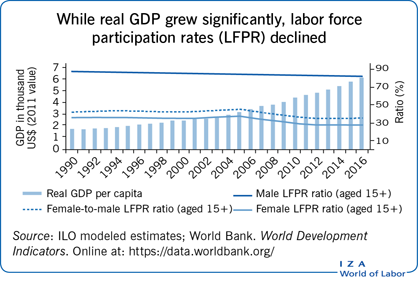Elevator pitch
The Indian economy entered an ongoing process of trade liberalization, domestic deregulation, and privatization of public sector units in 1991. Since then, per capita output has increased significantly, while the overall unemployment rate has remained low. However, labor force participation rates have fallen sharply, especially for women. In addition, youth unemployment remains stubbornly high, an overwhelming proportion of the labor force continues to work in the informal sector, and there is little evidence of a sustained rise in wages for either unskilled rural or factory workers.

Key findings
Pros
At present, real GDP per capita and real GDP per person employed are both about 3.5 times their respective 1991 levels.
The overall unemployment rate has remained essentially below 5% since 1991.
Average labor productivity in organized manufacturing is now almost three times higher than in 1990.
After a period of stagnation, unskilled rural wages increased by around 35% in the period 2007–2013; wages also rose in the organized manufacturing sector, though to a much lesser extent.
Cons
For young workers (aged 15–24), unemployment has remained steady at around 10%.
Since 2005, the labor force participation rate has fallen sharply for both women and younger men; the female participation rate fell relative to the male rate by around ten percentage points.
Labor productivity in agriculture and related sectors has fallen to about 30% of the economy-wide average, even as almost half the labor force remains in these sectors.
Over 90% of the labor force continues to be in the informal sector, with no job security or protective labor legislation.